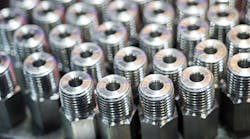Choosing CNC machining tolerances is critical to ensuring that a part is machined accurately and precisely. If you’re new to machining or working with a complex piece, you may wonder how to find the proper tolerances for your design. This article covers the top six tips for choosing CNC machining tolerances in a way that balances cost and precision.
1. Understand the Material. Understand the material you are working with, first and foremost. Different substances have different capabilities and needs that impact how they perform in CNC machining. A thorough understanding of the material you are using will allow you to determine possible tolerances with that substance.
Some metals are naturally more malleable (i.e., softer) than others, such as silver and gold. Due to greater malleability, achieving a tight tolerance with these metals is harder. They tend to respond more easily to every touch or contact. As a result, the machining process must be highly precise and controlled to achieve a tight tolerance.
Similarly, materials with low heat-resistance may struggle to hold up to extensive machining due to the high temperatures created by friction during machining. Other materials may be naturally more coarse, making them more expensive to machine down to highly tight tolerances. Carefully consider what your substance is realistically capable of achieving before choosing a tolerance.
2. Consider the Cost of Tight Tolerances. Cost is a significant factor in choosing CNC machining tolerances. Generally, tighter tolerances are more expensive. They require newer, sharper tools and exact equipment. Inspections may add to the cost, as well.
It can be challenging to balance cost and precision with complex parts, as they are more likely to require tight tolerances. However, if you’re working within a limited budget, tight tolerances for every aspect of the piece can force costs prohibitively high.
One way to approach this challenge is to consider how much money you are willing to spend on your part maximum, including everything needed to create it. If it is a part you are planning to mass produce for a commercial application, consider how much you want the end product price to be. Subtract out all of the other known and fixed costs for production. What is left over from that maximum budget is the maximum amount you can spend on machining.
3. Prioritize Structural Components. One way to keep down the costs of tight CNC machining tolerances is to prioritize tolerances for structural components. These aspects are critical to your part's structural integrity or functionality.
Precision screw parts are a great example. Well-machined screws, drive axles, gears and other precision screw components are critical for performance, safety and functionality on all kinds of parts and objects. Because these parts typically use a standard screw thread or other measurements, they have tight tolerances to be compatible with other critical parts.
For mission-critical parts like this, paying a little extra for tight tolerances is often worth it. If you are working on a limited budget, prioritize tighter tolerances for structurally essential parts first rather than trying to assign every aspect of your piece a tight tolerance.
4. Stick to Standard Tolerance Types. Standards and tolerance types are critical to choosing CNC machining tolerances. While materials don’t generally have industry-standard tolerances, there are a few types of tolerances most engineers and manufacturers use.
These three types are limit tolerances, bilateral tolerances, and unilateral tolerances. Each one is a different way of expressing tolerances and one type may create a more precise and complete understanding of the tolerance your part’s measurements require. Sticking to one of these three widely used tolerance types will make working with machinists and manufacturers easier.
Additionally, geometric dimensioning and tolerancing (GD&T) may be an option. While it can be costly, GD&T is worth considering for complex parts because it includes tolerances for numerous aspects of your piece, not just the dimensions. GD&T encompasses tolerances for feature locations, surface profile, orientation, rotational runout and form.
5. Keep Inspection Times in Mind. When choosing CNC machining tolerances, you should always consider inspection times. Generally, the tighter your tolerances are, the more thorough inspections will need to be.
Precision requires close attention to detail, so the inspection process for tight tolerances is more time-consuming than inspections for looser tolerances. These highly precise inspections for tighter tolerances can result in a higher price for your complex parts and a longer wait time for the finished product. This may not necessarily be a problem, but it is something to keep in mind.
6. Weigh the Options. When you are considering the precision needed to manufacture complex parts, it is worth weighing all the options that you have. CNC machining can result in high-quality, detailed, accurate pieces. However, it isn’t the only option on the table.
If you are working with a material that is difficult to machine or you need a few parts with a rapid turnaround time, additive manufacturing may be the better choice. There are several types of additive manufacturing, each with its own pros and cons.
CNC machining is the way to go for structural parts, components that need tight tolerances, or pieces that require an exceptionally smooth finish. Additive manufacturing may be a better alternative regarding non-structural components, pieces with looser tolerances, soft materials, or parts for rapid prototyping.
Machining Your Parts with Precision
Choosing CNC machining tolerances is vital to ensuring your part is accurate to the measurements you designed, especially when it comes to complex ones. Choosing standard tolerances, understanding your material and prioritizing tight tolerances for the right components of your piece can help you balance cost and precision in the machining process.
Emily Newton is the Editor-in-Chief of Revolutionized, an online magazine exploring the latest industrial innovations.






